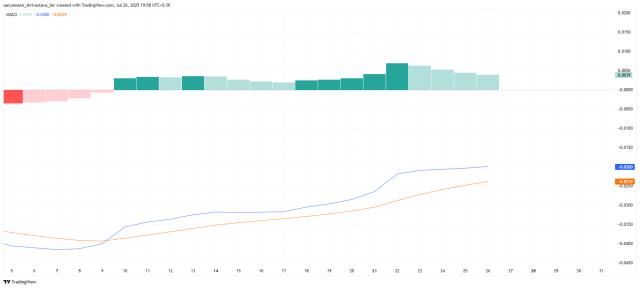
Bitcoin is witnessing an increase in distribution from hibernating holders, slowing but not preventing the current upward trend.
The number of Bitcoin held by long-term holders begins to decrease while capital flow from ETF funds remains positive, demonstrating a balance between selling pressure and market demand.
- The monthly CDD ratio over annual CDD of Bitcoin surges, signaling distribution from long-term holders.
- Bitcoin held by long-term holders decreased by 240,000 BTC, but demand from institutional investors remains strong.
- Distribution is slowing Bitcoin's price increase but not disrupting the long-term recovery trend.
What is the Increase in Distribution from Hibernating Bitcoin Holders?
Based on analysis by CryptoQuant expert Axel Adler, Bitcoin's monthly CDD ratio over annual CDD reached a high of 0.25 on 24/7, when BTC price fluctuated between 104,000 to 118,000 USD. This is an important indicator showing long-term holders are beginning to distribute coins.
In the past, similar peaks of this ratio appeared in 2014 and 2019, associated with deep Bitcoin corrections due to major events. This demonstrates the market experience of analysts as a reliable basis for interpreting the current trend.
The CDD increase shows experienced, long-standing holders are actively bringing coins to the market, signaling a distribution or profit-taking phase occurring simultaneously with the price trend.
"The sudden CDD ratio increase at this time indicates high selling pressure from long-term holders, similar to periods of significant volatility in Bitcoin's history."
Axel Adler, CryptoQuant Analyst, July 2025
How Has the Amount of Bitcoin Held by Long-Term Holders Changed?
Data from Checkonchain shows that in the past week, Holder Net Position Change reached -134.7 thousand BTC, meaning long-term holders are moving coins out of their wallets to sell on the market.
Simultaneously, the Bitcoin supply from long-term holders decreased from 14.12 million BTC to 13.88 million BTC, equivalent to 240,000 BTC being distributed. This is a sign that distribution is becoming more intense as Bitcoin's price increases.
History proves that when long-term holders distribute coins, the market typically faces downward price pressure. This is a warning factor about the possibility of correction or slowdown in price increase in the near future.
What is the Demand from Institutional Investors in This Period?
Despite distribution from long-term holders, institutional investment funds and Bitcoin ETF products continue to show positive capital flow, except for GBTC. Net flow from spot ETFs remains positive, with IBIT leading at 57.15 billion USD and FBTC at 12.33 billion USD.
This indicates that demand from large institutions remains steady, helping absorb supply from long-term holders and supporting stable Bitcoin prices within the trading range.
This balance helps maintain the price increase trend, though the speed may slow down due to increased selling pressure.
How Might Long-Term Holder Distribution Affect Bitcoin's Price Trend?
TinTucBitcoin's analysis assesses that pressures from long-term holder distribution have prevented Bitcoin from breaking the ATH of 123,000 USD, maintaining trading in the 115,000-120,000 USD range.
Meanwhile, demand from ETF funds and institutional investors remains high, creating important price support.
Therefore, this distribution may slow Bitcoin's growth rate but will not disrupt the long-term upward trend. If distribution decreases, the price has potential to recover and establish a new ATH.
"The combination of selling pressure from long-term holders and ETF capital flow will determine whether Bitcoin can break the upcoming ATH or continue consolidating in the current range."
TinTucBitcoin, Bitcoin Market Report, July 2025
Frequently Asked Questions
1. What is the CDD Ratio and How Does it Affect Bitcoin Price?
The CDD ratio reflects long-term holder distribution, with a strong increase often signaling selling pressure that may slow or reverse Bitcoin's price trend.
2. Why is the Decrease in Bitcoin Held by Long-Term Holders Important?
This decrease shows long-term holders are starting to sell coins, potentially causing long-term downward price pressure in the market.
3. Can ETF Capital Flow Counteract Selling Pressure from Long-Term Holders?
Positive ETF capital flow helps absorb sold coins, keeping Bitcoin price stable and supporting the long-term upward trend.
4. Will Bitcoin Surpass the ATH of 123,000 USD Soon?
If long-term holder distribution decreases, combined with strong ETF demand, Bitcoin may retest and exceed a new ATH.
5. How Can Investors Track Bitcoin Distribution from Long-Term Holders?
Investors should monitor CDD and Holder Net Position Change indicators through reliable platforms like CryptoQuant and Checkonchain.







